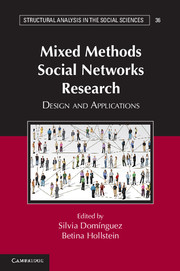Book contents
- Frontmatter
- Dedication
- Contents
- List of Tables
- List of Figures
- Contributors
- Foreword
- Acknowledgments
- Part I General Issues
- Part II Mixed Methods Applications
- 5 Social Networks, Social Influence, and Fertility in Germany
- 6 Two Sides of the Same Coin
- 7 Adaptation to New Legal Procedures in Rural China
- 8 Mixing Ethnography and Information Technology Data Mining to Visualize Innovation Networks in Global Networked Organizations
- Part III New Methodological Approaches Used in Mixed Methods Designs
- Index
- References
6 - Two Sides of the Same Coin
The Integration of Personal Network Analysis with Ethnographic and Psychometric Strategies in the Study of Acculturation
Published online by Cambridge University Press: 05 July 2014
- Frontmatter
- Dedication
- Contents
- List of Tables
- List of Figures
- Contributors
- Foreword
- Acknowledgments
- Part I General Issues
- Part II Mixed Methods Applications
- 5 Social Networks, Social Influence, and Fertility in Germany
- 6 Two Sides of the Same Coin
- 7 Adaptation to New Legal Procedures in Rural China
- 8 Mixing Ethnography and Information Technology Data Mining to Visualize Innovation Networks in Global Networked Organizations
- Part III New Methodological Approaches Used in Mixed Methods Designs
- Index
- References
Summary
In this chapter we propose and describe a mixed method approach to assess the process of acculturation of host individuals, based on previous ethnographic and psychometric research of Latina immigrants in Boston (US) and Latin American immigrants in Andalucía (Spain) (Domínguez and Maya-Jariego 2008). Personal network analysis and visualization are combined with interviews, participant observation, and psychometric scales in a two-way iterative process of research, based on the assumption of a contingent relationship between the kind of acculturation experience and the type of personal network. This procedure is particularly useful to understand the complexities of the process of acculturation, taking into account both the topology on the intergroup situation and the interactive nature of the intercultural contact.
This chapter illustrates the application of a sequential explanatory design for the study of acculturation. It mainly uses the description of personal networks (Hollstein 2011) in combination with ethnography, observation, and the application of psychometric scales. The contributions to investigating social networks consist of the incorporation of network perceptions and interpretations by participants, examining how individuals position themselves in the social environment.
- Type
- Chapter
- Information
- Mixed Methods Social Networks ResearchDesign and Applications, pp. 153 - 176Publisher: Cambridge University PressPrint publication year: 2014
References
- 2
- Cited by

